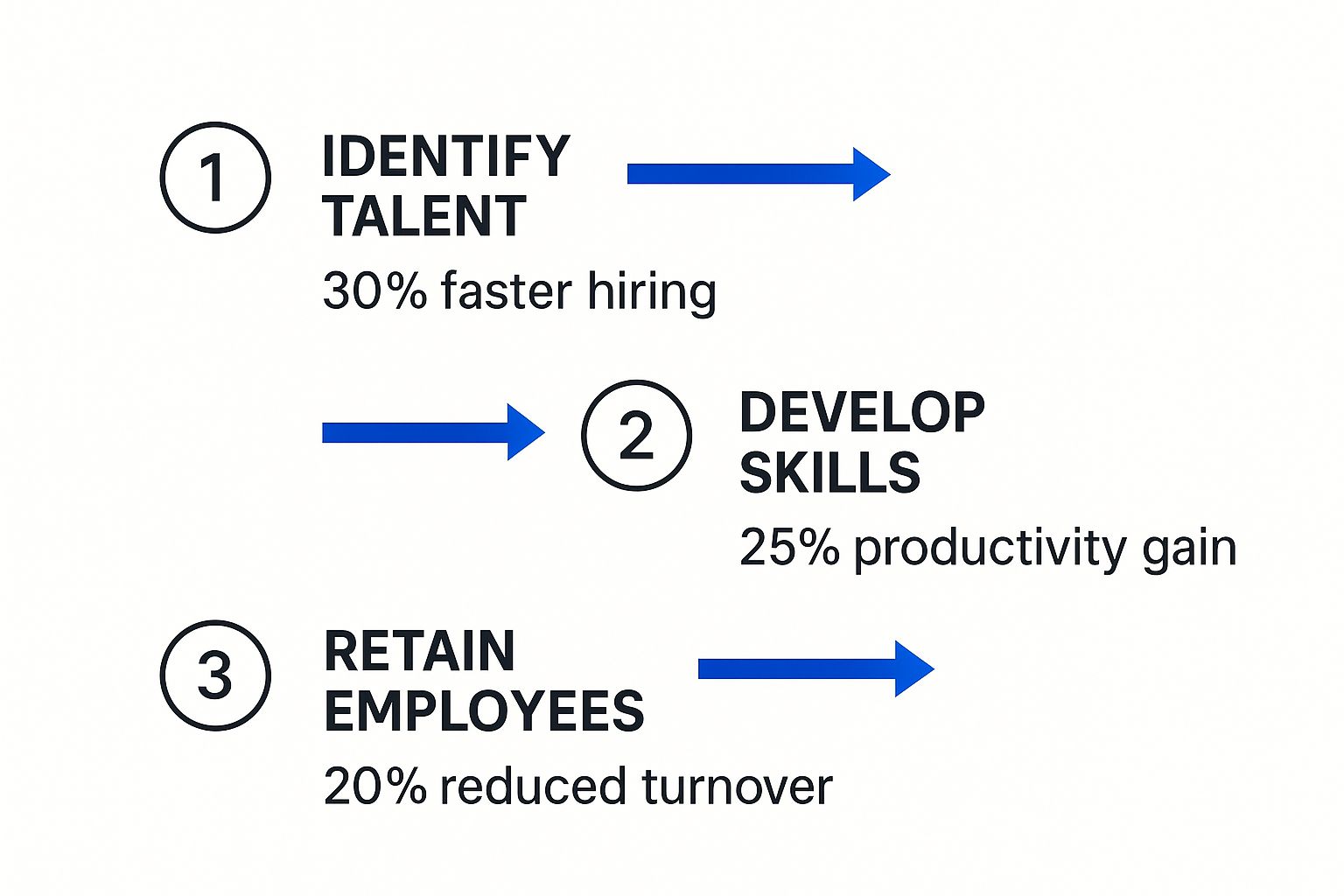Talent management is the big-picture strategy for how you attract, grow, and keep the best people to help your business succeed. It’s a company-wide commitment to not just hire staff, but to manage and develop them, recognising that your people are your most important asset.
What Is Talent Management in Simple Terms?

Let's cut through the corporate jargon. Think of yourself as the manager of a top-tier sports team. Your job isn't just to sign a few star players for the current season. You're constantly scouting for new talent, coaching your existing players to sharpen their skills, and making sure everyone works well together. You're building a team that can dominate the league for years to come.
That’s talent management in a nutshell. It’s your strategic playbook for the entire employee lifecycle, from the first interview to their last day. It goes far beyond simply filling an empty seat and ensures you have the right people in the right roles, ready to tackle today's challenges and tomorrow's opportunities. This approach weaves separate HR tasks into one cohesive, powerful strategy.
The Core Pillars of a Talent Management Strategy
While many people think talent management is just about hiring, that's only the first chapter of the story. The recruitment process is a crucial starting point, which you can learn more about in our guide on what is talent acquisition. However, a truly effective strategy integrates this with several other key pillars that support each other.
Talent management isn't a single HR task; it's the continuous cycle of finding, nurturing, and keeping the people who will drive your organisation's success. It shifts the focus from simply filling positions to building long-term organisational capability.
Each component of a talent management strategy is designed to unlock an employee’s full potential and align it with the company's vision. To give you a clearer picture, this table breaks down the core pillars and what they aim to achieve.
The Core Pillars of a Talent Management Strategy
As you can see, each pillar builds on the last, creating a strong framework that not only attracts top performers but also nurtures them into the future leaders of your organisation.
Here is the rewritten section, crafted to sound human-written and natural.
The True Cost of Neglecting Your Talent Strategy
Let's be blunt: ignoring your talent management strategy isn't just a missed opportunity. It's an active financial drain on your business. When you treat recruitment, development, and retention as separate chores instead of a cohesive plan, you create hidden costs that steadily chip away at your profits. Without a strategy, you're not just firefighting—you're paying a hefty price for every emergency.
This reactive approach is particularly punishing in a competitive market. Businesses that don't strategically look after their people find themselves battling higher staff turnover, watching productivity slide, and losing their creative spark. Think of it this way: you're constantly trying to patch a leaking bucket instead of building a stronger one in the first place.
The Financial Impact of Skills Gaps
The numbers behind a disconnected talent approach are genuinely staggering. Right now, the widespread skills shortage is estimated to be costing UK businesses a massive £6.6 billion every year. This isn't some abstract problem; it has very real consequences. Around 33% of all UK employers say they have vacancies that are hard to fill, and that number jumps to 45% in the private sector. You can find more detail in these HR statistics.
When you can't find the right people, roles stay empty for longer, existing teams get stretched to their breaking point, and you inevitably miss out on new business. The pressure to just get someone—anyone—in the door often leads to rushed, poor hiring decisions, which only makes the whole situation worse.
A single bad hire at a managerial level can set a business back by as much as £132,000. That figure accounts for everything: recruitment fees, salary, wasted training, and the toxic effect on team morale and output.
When you look at it this way, the picture becomes crystal clear. The cost of not having a solid talent management plan is far greater than the investment it takes to create one. It’s a critical financial decision that directly affects whether your organisation can survive and thrive. A proactive strategy isn't a "nice-to-have" anymore; it's an economic necessity.
How to Build an Effective Talent Management Process
So, how do you move from simply understanding talent management to actually doing it? The secret is to stop thinking of it as a one-off project and start treating it like a continuous cycle. It's a living, breathing system where each part fuels the next, creating a powerful engine for your company’s growth.
Think of it like building a high-performance race car. You need the right parts (your talent), a clear assembly process (onboarding and development), and a dedicated pit crew for regular maintenance (performance management and retention). Each step is absolutely crucial to keep the whole thing running at peak performance.
Mapping the Talent Journey
A truly effective process guides an employee from their very first contact with your company all the way through to their long-term growth. While you can—and should—tweak the details to fit your business, the core stages are pretty universal. A central piece of this puzzle is knowing how to build a performance management system that works, because it sits at the heart of both development and engagement.
This journey typically breaks down into a few key steps:
- Strategic Workforce Planning: This is where you look at the team you have today and realistically forecast what skills and roles you'll need tomorrow to hit your business goals.
- Attraction & Recruiting: It’s all about building a strong employer brand to source top people who are a great fit for both the job and your company culture.
- Onboarding: This critical step is about smoothly integrating new hires and setting them up to succeed from their very first day.
- Performance Management: Forget annual reviews. This means setting clear goals and giving regular, constructive feedback that actually helps people improve.
- Learning & Development: You have to offer targeted training and genuine growth opportunities to upskill your team and keep them challenged.
- Succession Planning: This is your long game—identifying and grooming high-potential employees to step into future leadership roles.
- Retention & Engagement: The final piece is creating a positive environment where your best people feel valued, heard, and motivated to stick around.
This infographic lays out how these stages flow together, showing how finding, developing, and keeping great talent leads to real business wins.

It’s clear from the data that having a structured approach pays off in big ways, from hiring faster to slashing employee turnover.
The most important thing to remember is that these stages aren't isolated islands. Great development programmes will naturally identify your future leaders for succession planning. Strong performance management will give you the insights you need to improve your retention strategies. Everything is connected.
By putting this cycle into practice, you're not just filling empty seats. You're building a sustainable framework that makes your entire organisation stronger. This proactive approach ensures you always have the right people with the right skills ready to push your business forward.
Why Engaged Employees Are Your Greatest Asset

Getting top talent through the door is just chapter one. The real story of a company’s long-term success is written by keeping those brilliant people motivated, engaged, and invested in your mission. A smart talent management process is what gets you there, creating a team that doesn't just clock in and out, but actively drives the business forward.
Think of it this way: a disengaged employee is like a car stuck in first gear—it gets the job done, but slowly and with a lot of effort. An engaged employee? That's a high-performance engine, firing on all cylinders. They bring the extra creativity and drive that separates the good companies from the truly great ones.
Engagement As a Business Barometer
How your people feel about their jobs is a surprisingly accurate measure of your company's overall health. Recent data shows that even with a dip in job satisfaction, worker confidence in the UK remains quite high. ManpowerGroup's Global Talent Barometer found that 71% of UK workers feel positive about their work. This is a huge opportunity, especially when 36% of companies report that finding skilled candidates is their biggest hiring headache.
When your talent management is firing on all cylinders, the results are tangible. You don't just get a happier team; you build a powerful, self-sustaining asset for the business.
An engaged workforce isn't just a happier one; it's a more productive, innovative, and loyal one. Effective talent management builds the culture that makes this possible, turning employee potential into measurable business performance.
A key piece of this puzzle is making sure everyone understands what success looks like in their role. It’s well worth learning about setting effective Key Performance Indicators for employees, because when people see how their work contributes to the bigger picture, their engagement naturally deepens.
Ultimately, investing in your team through clear career paths, good communication, and genuine recognition does more than just reduce staff turnover. Our guide on how to improve employee retention dives deeper into these strategies. It builds a team of advocates who champion your business with real passion and purpose.
Navigating Common Talent Management Hurdles

Even the most well-thought-out talent management strategy can hit a wall when faced with real-world business pressures. Many organisations discover a frustrating gap between their ambitious plans and what they can realistically achieve day-to-day. Getting a handle on these common hurdles is the first, most crucial step toward building a plan that actually works.
These aren't just minor bumps in the road; they can completely derail your efforts. From stretched budgets and competing business priorities to a simple lack of in-house know-how, plenty of obstacles can stand in your way. Spotting them early on means you can build a smarter, more resilient strategy from the ground up.
Financial constraints are often the biggest barrier. Recent survey data shows that around 65% of organisations plan to keep their talent management budgets flat for 2025, a clear sign of cautious spending. If you'd like to read more, you can explore more top talent management trends. For leaders, this means any new initiative has to make a very strong case for its value.
The Gap Between Confidence and Readiness
This cautious spending often goes hand-in-hand with another major problem: a lack of genuine preparedness. In the same survey, while 73% of respondents felt their organisation was "somewhat prepared" for future talent demands, a mere 7.6% felt "fully prepared." This disconnect—knowing what's coming but not having the tools to face it—is a story we hear all the time.
This gap highlights a core challenge in talent management today. Many leaders see the problems on the horizon but struggle to secure the budget, tools, or buy-in needed to address them proactively.
So, how do you close this gap? By focusing your efforts. Instead of trying to boil the ocean, pinpoint the areas where you can make the biggest impact. For most businesses, that starts with holding onto their best people. Our guide on employee retention strategies is packed with ideas that deliver a strong return, even on a tight budget.
Other significant barriers often include:
- Outdated Technology: Trying to manage talent with clunky spreadsheets is not just inefficient; it's a recipe for mistakes.
- Skills Shortages: Sometimes the very team in charge of talent management lacks the strategic or analytical skills needed for the job.
- Employee Fatigue: If your teams are already feeling the strain, they're likely to push back against new development programmes or performance reviews.
By anticipating these issues, you can create a talent management plan that’s built for the real world, not just for a boardroom presentation.
Frequently Asked Questions About Talent Management
Even with a solid plan, it’s natural to have questions when you start putting talent management into practice. Let's clear up some of the most common queries with straightforward answers to help you find your footing.
What’s the Difference Between Talent Management and HR?
It helps to think of Human Resources (HR) as the foundational bedrock of your entire company. HR manages the essential functions that keep the business compliant and running smoothly for every single employee—things like payroll, benefits, and workplace policies. It’s the broad, universal framework that supports everyone.
Talent management, on the other hand, is much more targeted. It’s a strategic discipline that zeroes in on attracting, nurturing, and keeping the key people who will drive your business forward. If HR keeps the entire engine running, talent management is about fine-tuning it for maximum performance.
While HR looks after the whole workforce, talent management is a strategic focus on getting the absolute most from your most critical asset—your top people. They’re two sides of the same coin, but they have different goals.
How Can a Small Business Start With Talent Management?
You don’t need a massive budget or complex software to get started. For a small business, the secret is to begin with a clear, focused plan that can scale as you grow.
The best way to start is by identifying the two or three roles that are absolutely vital for your company’s immediate and future success. Forget about trying to do everything at once. Just concentrate on perfecting how you hire and develop people for those specific positions.
Here are a few practical first steps:
- Swap formal reviews for regular chats: Ditch the once-a-year review and opt for simple, frequent performance conversations instead. Keep it light and consistent.
- Identify and invest: Pick one or two employees who show real potential and create a straightforward development plan. This could be as simple as an online course or a mentorship with a senior team member.
- Focus on critical roles: Put your energy into improving how you find and keep the people who fill your most important jobs.
This targeted approach lets you build good talent management habits without getting swamped.
What Role Does Technology Play in Modern Talent Management?
Technology is the great enabler. Modern tools can handle the repetitive, time-sucking admin work that often buries HR teams, freeing them up to focus on what really matters: people and strategy. Good tech doesn't just support your strategy; it makes it better by providing data and efficiency.
For instance, an Applicant Tracking System (ATS) can bring much-needed order to your hiring process, while a Learning Management System (LMS) makes it easy to scale up employee training. These systems give you the data you need to make smarter decisions about everything from performance to who’s ready to step into a bigger role.

